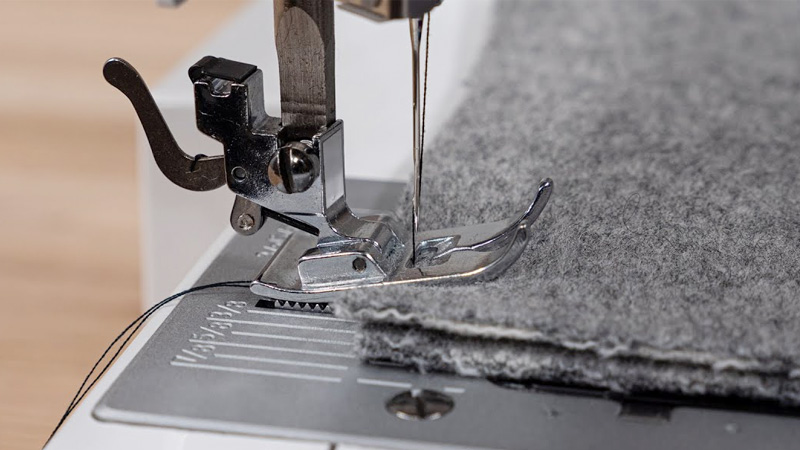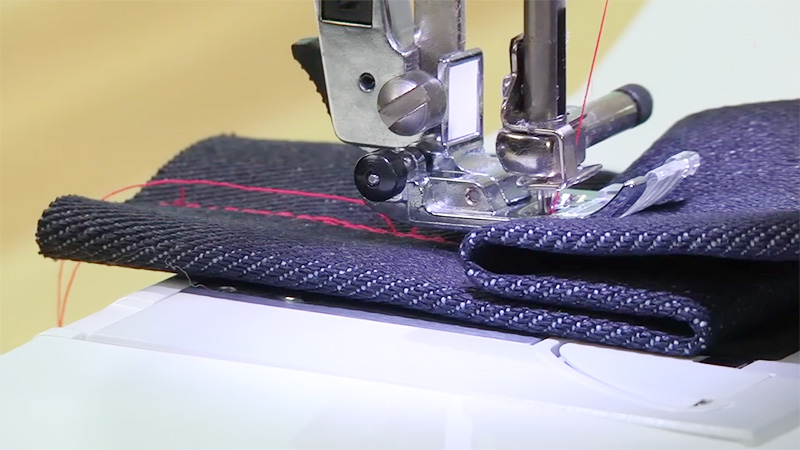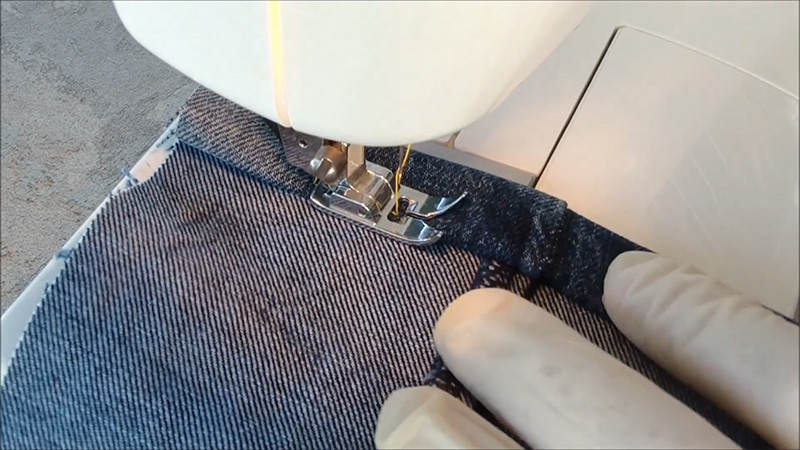Sewing thick fabric requires a different set of skills and considerations compared to working with lighter materials. Whether you’re tackling denim, canvas, upholstery fabric, or other heavy textiles, the challenges and rewards are unique.
Thick fabrics are often chosen for their durability and sturdiness, making them popular for projects like bags, upholstery, outdoor gear, and heavy-duty clothing.
Successfully sewing thick fabric involves selecting the right equipment, such as heavy-duty needles and thread, and mastering techniques that ensure clean seams and professional results.
It’s a skill that requires patience and practice, but with the right knowledge and tools, you can conquer the challenges and create impressive projects that stand the test of time. Let’s discuss Sewing Thick Fabric.

Sewing Thick Fabric
Sewing thick fabric can be a challenge, but with the right techniques, you can achieve professional and durable results.
Here are the simple methods:
Use the Right Needle:
Start by selecting a heavy-duty or denim needle specifically designed for thick fabrics. A larger needle size will help penetrate the fabric more effectively, preventing skipped stitches.
Adjust Your Machine’s Tension:
Experiment with your sewing machine’s tension settings. You may need to increase the tension slightly to ensure the stitches are tight and secure on thick fabrics.
Choose the Correct Thread:
Opt for a strong and thicker thread like a heavy-duty polyester or nylon thread. This ensures the seams are robust and less likely to break.
Walking Foot Attachment:
Attach a walking foot to your sewing machine. This specialized foot helps feed thick fabrics evenly and prevents layers from shifting as you sew.
Presser Foot Pressure Adjustment:
If your sewing machine allows it, adjust the presser foot’s pressure. Reducing pressure can be helpful when sewing through thick layers, preventing fabric distortion.
Lengthen Your Stitch Length:
Increase your stitch length slightly. Longer stitches are less likely to create excessive tension and puckering on thick fabrics.
Practice Hand Cranking:
When dealing with particularly thick sections, consider using the hand crank on your sewing machine to manually guide the needle through the layers. This allows for better control and precision.
With these methods, sewing thick fabric becomes more manageable and yields clean, strong seams. Don’t forget to test your settings and practice on scrap fabric to ensure you achieve the desired results before working on your main project.
What Stitch Is Best For Thick Fabric?

When sewing thick fabric, choosing the right stitch is crucial for achieving strong, durable, and attractive seams.
Here are the stitches that work well with thick fabrics:
Straight Stitch:
The straight stitch is a basic, versatile option for sewing thick fabrics. Use a longer stitch length to prevent excessive puckering and ensure the seam is secure. It’s ideal for most heavyweight materials like denim and canvas.
Triple Stitch:
The triple stitch is a reinforced straight stitch that adds extra strength to seams. It creates three parallel lines of stitching, making it ideal for areas that undergo significant stress, such as heavy-duty workwear or bags.
Zigzag Stitch:
The zigzag stitch is excellent for preventing fraying on thick fabric edges. Use it along raw edges or to secure seams. Adjust the stitch width and length to suit your fabric type and project requirements.
Basting Stitch:
A basting stitch is a temporary, long, straight stitch used for holding thick fabric layers together before final sewing. It’s a helpful step when working on complex projects with multiple layers.
Overlock Stitch:
An overlock stitch, also known as a serger stitch, is perfect for finishing raw edges on thick fabrics. Many sewing machines have built-in overlock stitches, or you can use a serger for professional-looking edges.
Decorative Stitches:
Many sewing machines offer decorative stitches that can be used to add both style and reinforcement to your thick fabric projects. Experiment with these stitches to create unique designs on your creations.
Bar Tack Stitch:
A bar tack stitch is a short, dense zigzag stitch used for reinforcing stress points, such as pocket corners or belt loops on thick garments. It provides extra durability in areas subject to strain.
The choice of stitch depends on your specific project and the type of thick fabric you’re working with.
Be sure to adjust your machine’s settings, including stitch length and tension, as needed, and practice on scrap fabric to ensure the desired results before sewing your main project.
Why Is My Sewing Machine Not Working On Thick Fabric?

Experiencing issues with your sewing machine when working on thick fabric can be frustrating, but there are several common reasons why this may happen.
Here are the potential causes:
Incorrect Needle Choice:
Using the wrong type or size of needle is a common issue. Thick fabrics require a heavy-duty or denim needle to penetrate the material effectively. Using a standard needle can lead to skipped stitches and fabric jams.
Tension Misalignment:
Incorrect tension settings can cause problems when sewing thick fabrics. If the tension is too high, the fabric may pucker, or the thread could break. Conversely, if the tension is too low, stitches may be loose and uneven.
Thread Quality:
Low-quality or lightweight thread may not be strong enough for sewing thick fabrics. Choose a heavy-duty thread suitable for the material to prevent breakage and ensure sturdy seams.
Presser Foot Pressure:
Inadequate presser foot pressure can result in uneven feeding of thick fabric layers. Adjust the presser foot pressure to a higher setting to help the machine grip and feed the material evenly.
Machine Speed:
Sewing too quickly when working with thick fabric can overwhelm the machine. Slow down your sewing speed to allow the machine’s feed dogs to move the fabric accurately.
Dull or Incorrectly Installed Needle:
A dull needle or one that’s incorrectly installed can struggle to penetrate thick fabrics. Ensure the needle is inserted correctly, and replace it when it becomes dull to maintain smooth stitching.
Inadequate Machine Power:
Some sewing machines, especially lightweight or basic models, may lack the power needed to sew through extremely thick fabrics. In such cases, consider using an industrial or heavy-duty sewing machine designed for heavy materials.
Identifying and addressing these issues can significantly improve your sewing machine’s performance on thick fabrics. Regular maintenance, choosing the appropriate tools and settings, and practicing on scrap fabric before your main project can help you achieve better results and a smoother sewing experience.
FAQ
What are some common challenges when sewing thick fabrics?
When sewing thick fabrics, consider using a heavy-duty or denim needle, reducing presser foot pressure, and adjusting your machine’s tension settings to accommodate the fabric’s thickness.
Can I use a regular sewing machine for thick fabrics?
Yes, you can use a regular sewing machine for thick fabrics. However, it may require some adjustments to the machine’s settings and the use of appropriate needles and thread.
What types of projects typically involve sewing thick fabrics?
Projects like upholstery, outdoor gear, denim jeans, and winter coats often involve sewing thick fabrics due to their durability and insulation properties.
How do I prevent skipped stitches when sewing thick materials?
To prevent skipped stitches, ensure your needle is sharp and appropriate for heavy fabrics. Use a slow and steady sewing pace, and consider using a walking foot or a Teflon presser foot to help feed the fabric evenly.
Are there specific sewing techniques for thick fabrics?
Yes, techniques like grading seams, clipping corners, and using a hump-jumper (a tool to help your machine move over thick areas) can be helpful when sewing thick fabrics. Additionally, reinforcing stress points with extra stitching can add durability to your project.
Conclusion
In the world of sewing, the ability to work with thick fabrics is a valuable skill that opens the door to a wide range of creative possibilities. As we conclude our exploration of sewing thick fabric, we recognize that the challenges it presents are matched by the satisfaction of creating durable, functional, and beautiful items.
By understanding the importance of needle and thread selection, adjusting tension settings, and mastering techniques like basting and topstitching, you can confidently take on thick fabric projects.
Whether you’re making a rugged jacket, a sturdy tote bag, or upholstering furniture, the ability to sew thick fabric will empower you to bring your creative visions to life with skill and precision.
Leave a Reply